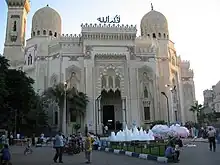After Alexandria fell under Muslim control, it gradually lost its importance since the newly created Empire was not dependent on land and had other ports nearby like Damietta, and Palestinian ports, but nevertheless the city includes several large and important mosques. After Napoleon came in, the city started to regain its power over the nearby port of Rosetta. Today, the city is the second largest in Egypt and one of the most important Mediterranean Sea ports.
Rashidunids
- Attarin mosque[1] see Commons, 1057 A.D. (370–641 St. Athanasius church)
Abbasids
Fatimids
Ayyubids
Mamluks

Mosque of Al-Mursi Abu Al-Abbas
- Mosque of Sidi Gaber
- Mosque of El-Nabi Daniel, 13th century
- Al-Shatibi mosque
- Al-Tartoushi mosque
Ottomans and Alawiyya Dynasty

Mosque of Sidi Bishr.
- El-Mursi Abul Abbas Mosque
- Imam Albusiri mosque
- Mosque of Sidi Yaqout Al-Arsh
- Mosque of Sidi Bishr
- Terbana mosque, 1684 ad.
Modern
External links
References
This article is issued from Wikipedia. The text is licensed under Creative Commons - Attribution - Sharealike. Additional terms may apply for the media files.